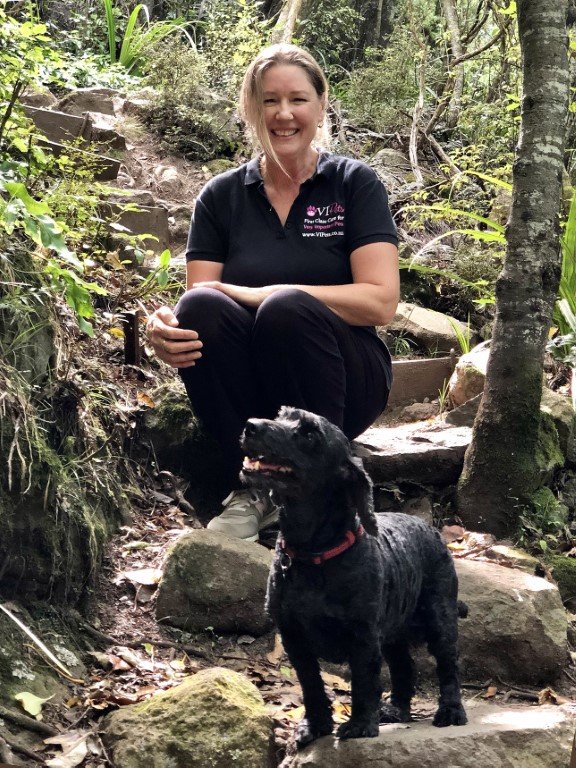After years of researching ingredients for my VIPets treats and treating my own adventure dogs, I’ve learned quite a bit about these little nutritional powerhouses. At first, I found myself wondering whether these seeds were just another human food trend being marketed to pet parents, or if they genuinely offered benefits for our four-legged friends. If you’ve been curious whether chia seeds are good or bad for dogs, you’re not alone!

What Are Chia Seeds Anyway?
Chia seeds come from a plant called Salvia hispanica, which is related to mint. These tiny black and white seeds were a staple food for the ancient Aztecs and Mayans. In recent years, they’ve become popular in human health foods because they pack quite a nutritional punch for their size.
They’re those same little seeds that grow into the green sprouts on those novelty Chia Pets that were all the rage in the 90s! (I may be showing my age here, but anyone else remember those clay animals that grew “hair”?)
The Good News About Chia Seeds for Dogs
Let’s start with the positives, because there are quite a few reasons these seeds might benefit your furry friend:
1. They’re Packed with Nutrition
Chia seeds contain:
- Omega-3 fatty acids (good for skin, coat, and reducing inflammation)
- Fibre (helps with digestion)
- Protein (building blocks for muscles)
- Calcium (for strong bones and teeth)
- Phosphorus (important for energy and cell repair)
- Antioxidants (help fight cell damage)
My dog Casey had always struggled with dry, flaky skin during winter. When I started adding a small amount of chia seeds to her food three times a week, I noticed her coat became noticeably shinier within a month. The omega-3s in the seeds helped improve her skin moisture from the inside out.
2. They Can Help Digestion
The fibre in chia seeds can help dogs with mild constipation or irregularity. They absorb water and form a gel, which can help move things along in the digestive tract.
I once looked after a senior dog named Max who needed a little help in this department. His owner and I tried a quarter teaspoon of chia seeds mixed with water (more on proper preparation below), and it helped him become more regular without medication.
3. They Might Help With Weight Management
Because chia seeds absorb water and expand, they can help your dog feel fuller for longer. This can be helpful if your pup needs to shed a few kilos (with your vet’s guidance, of course).
These seeds also provide energy without a heap of calories, which makes them a good addition for active dogs.
The Potential Concerns
Now, chia seeds aren’t perfect for every dog in every situation. Here are some important points to consider:
1. Choking or Blockage Risk
For very small dog owners, this is probably the biggest concern with chia seeds. When dry, they’re very small and might seem harmless. However, chia seeds absorb water — a lot of water. They can expand to about 10-12 times their dry size!
If your very small dog eats dry chia seeds and then drinks a lot of water, the seeds could expand in their throat or digestive tract, potentially causing a blockage. This is rare but possible.
2. Not All Dogs Need The Extra Nutrition
If your dog is already eating a complete and balanced diet with appropriate supplements as needed, they might not need the extra nutrition from chia seeds. Adding too many supplements can sometimes create imbalances.
3. Allergic Reactions Are Possible
While uncommon, some dogs might be allergic to chia seeds. If your dog has a known seed allergy, it may be best to avoid them. Watch for signs like itching, paw licking, ear infections, or digestive upset when introducing any new food.
How to Safely Feed Chia Seeds to Your Dog
If you’ve decided to try chia seeds with your dog, here’s how to do it safely:
1. Always Prepare Them Properly
Never feed dry chia seeds on their own to your dog. Instead:
- Mix the seeds with water and let them sit for at least 10 minutes before serving
- They should form a gel-like consistency
- This prevents the expansion from happening inside your dog
2. Start Small
Begin with just a tiny amount — about ⅛ teaspoon for small dogs or ¼ teaspoon for larger dogs — mixed into their regular food. Watch for any digestive changes over 24-48 hours before continuing. I would start out with around 2-3 of my apple and peanut butter treats to start with, and build up from there.
3. Don’t Overdo It
Even good things can cause problems in large amounts. For most dogs, these amounts are plenty:
- Small dogs (under 10kg): ¼ teaspoon
- Medium dogs (10-20kg): ½ teaspoon
- Large dogs (over 20kg): 1 teaspoon
I give my adventure dogs my beetroot and coconut treats with chia seeds just 2-3 times per week, not daily. This provides benefits without risking nutritional imbalances. One other side effect of the beetroot treats is too many turn their poop a dark red! (This can be disconcerting for some pet parents, so they always get a warning on beetroot treat days!)
4. Check with Your Vet First If Your Dog Has Health Issues
Dogs with certain conditions should probably avoid chia seeds:
- Dogs with known seed allergies
- Dogs with swallowing difficulties
- Dogs on blood-thinning medications (due to the omega-3 content)
- Dogs with certain digestive disorders (the extra fibre might irritate some conditions)
Simple Ways to Add Chia to Your Dog’s Diet
If you’d like to try chia seeds with your dog, here are some easy ways to incorporate them:
Basic Chia Gel: Mix 1 teaspoon of chia seeds with 3 tablespoons of water and let sit for 10 minutes until it forms a gel. Add a small portion to your dog’s regular food.
Frozen Chia Treats: Mix chia gel with a bit of pumpkin purée or plain yogurt and freeze in ice cube trays for a cooling summer treat.
Homemade Dog Treats: If you bake your own dog treats, you can add pre-soaked chia seeds to the dough. The batch I make with chia seeds, apple, and peanut butter is always a huge hit with my adventure dogs!
The Bottom Line on if Chia Seeds Are Good or Bad for Dogs
Like many things in pet nutrition, the answer isn’t black and white.
Properly prepared chia seeds can be a beneficial addition to many dogs’ diets when used in moderation. They provide excellent nutrition and can help with various aspects of health.
However, they must be prepared correctly, introduced slowly, and given in appropriate amounts. And they’re not necessary for every dog, especially if your pup is already eating a complete and balanced diet.
I’ve found that for my adventure dogs, occasional chia seed treats work well. But every dog is different, and what works for mine might not work for yours.
Have you tried chia seeds with your dog? I’d love to hear about your experience in the comments below!
DISCLAIMER: This article is based on my experience and research, but I’m not a veterinary nutritionist. Always check with your vet before making significant changes to your dog’s diet, especially if they have existing health conditions.







